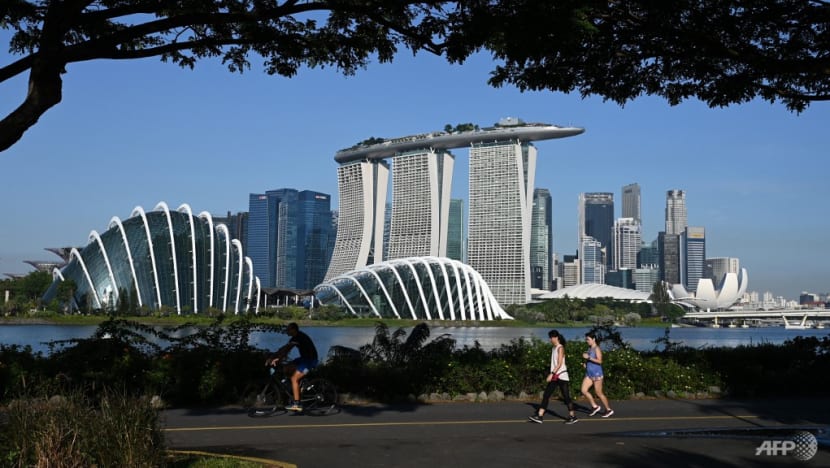Is Singapore really a Blue Zone? Experts weigh in on how healthy Singaporeans are
A Blue Zone is a place where people live longer and enjoy better health well into old age. We look at whether and how Singapore steps up to this latest accolade.

People walk and cycle through the Bay East Garden in Singapore on Aug 9, 2021. (File photo: AFP/Roslan Rahman)
- Singapore was recently named a Blue Zone 2.0, where people live longer and lead healthier lives. But unlike other Blue Zones where traditional ways of life have naturally led people to longevity, it is an “engineered” Blue Zone
- Health Minister Ong Ye Kung has said that the country should strive to be a Blue Zone 3.0
- Health and longevity experts weigh in on what has worked so far and how Singaporeans can lead healthier lives
SINGAPORE: Okinawa, Sardinia and Singapore. What do these places have in common? Besides all being islands, Okinawa is in Japan, Sardinia in Italy and Singapore in Southeast Asia.
In a recent Netflix series titled Live to 100: Secrets of the Blue Zones, they were among six places named healthy “Blue Zones”. Popularised by New York Times bestselling author Dan Buettner, a Blue Zone is a region with a high concentration of centenarians or 100-year-olds.
These are places where people live longer and enjoy better health well into old age. In his book The Blue Zones, Buettner named five original Blue Zones – besides Okinawa and Sardinia, there is Ikaria in Greece, Loma Linda in California and the Nicoya Peninsula in Costa Rica.
Each of these pockets of longevity has developed a way of life where people eat plant-based diets, are active daily, have a sense of purpose and are engaged in close-knit communities.
Singapore was named a sixth Blue Zone 2.0 this year in the four-part documentary on Netflix, yet it does not fit the mould of these five.
At a symposium for successful ageing last Thursday (Oct 12), Health Minister Ong Ye Kung pointed out that Singapore is distinctively different from the other Blue Zones. To record one of the highest lifespans and health spans in the world appears to be an anomaly, he said.
“Good healthy habits are not inherent in our traditional culture and lifestyle. Singapore is nothing like Okinawa or Sardinia,” he said.
“On the contrary, we eat food that is rich in sugar, salt and santan (coconut milk in Malay), very often deep fried; we are not endowed with vast expanse of nature that encourages outdoor activities; the pace of life is fast and stressful.
“Many families keep to themselves and do not even talk to their immediate neighbours.”
The results of recent health surveys also indicate that for many here, our daily habits are not the best for our health.
Last month, a nutrition survey by the Health Promotion Board found that nine in 10 Singapore residents consumed too much salt, and their salt intake has risen in recent years. Another national health survey found that the prevalence of hypertension, or high blood pressure, has nearly doubled among Singaporeans since 2010.
Singapore residents are also eating more, while the proportion of residents who get enough exercise – at least 150 minutes of physical activity a week – has gone down significantly from 85 per cent in 2019 to 75 per cent last year.
The upshot: More people (61 per cent) are exceeding their daily recommended calorie intake after factoring in physical activity.
But there’s one silver lining. Residents here are consuming less sugar, after regulations on labelling sugared drinks and other anti-diabetes measures kicked in.
JUMP IN LIFESPANS
In the documentary, Buettner concedes that the lifestyles of the Blue Zones are disappearing as current generations adopt modern diets and habits. This is as traditional practices are replaced by fast-food chains and we become more sedentary and solitary.
But he hopes to create new Blue Zones, places where policy can shape a healthier environment – which is the thinking behind naming Singapore a Blue Zone 2.0 or an “engineered” Blue Zone.
When contacted, Buettner said that life expectancy in Singapore jumped over 20 years within a lifetime, while the other five Blue Zones evolved slowly over centuries. It’s an outcome the rest of the world envies, he said.
For example, with a car ownership rate of 11 per cent, this means that 89 per cent of people here have to walk to get to a store, to see their friends and run their errands. This adds up to "more physical activity than you think", he said.
"I don’t think Singaporeans realise how much they move naturally. The people I interviewed took this non-exercise physical activity for granted when in fact, in many cases, it added up to over 6,000 to 8,000 steps per day.”
Compared with many other countries, Singapore does well on measures of health. The Global Burden of Disease 2019 study ranked Singapore first globally for both life expectancy and healthy life expectancy, ahead of Japan.
If you live in Singapore, you can expect to live, on average, to about 84 years of age. More importantly, the number of years you live in good health is also likely to be the highest in the world, at an average of 74 years.
Singapore has created this outcome through infrastructure and programmes that nudge our people towards healthier behaviours, said Mr Ong.
“Just like Singapore is a nation created by conviction and will, Singapore as a Blue Zone is constructed through policy,” he said.
Experts here agree. Dr Laureen Wang attributes Singapore residents’ stellar life expectancy to a number of factors including stable and good governance, economic security, accessible health care and public health policies – such as childhood immunisation programmes and how COVID-19 was handled.
The cardiologist and head of Alexandra Hospital’s Well Programme also cited social factors – a high literacy rate and social support, in part due to our Asian culture and also family and friends being close by for many in a small country.
Other experts pointed out medical advancements that have decreased maternal and child mortality and a good healthcare system that has increased the likelihood of people with chronic conditions living longer.
All this has contributed to a jump of 20 years in the population’s lifespan from the 1960s until now. But will this last?
HIDDEN FAT, LACK OF SLEEP
Dr Wang thinks that Singaporeans can definitely improve their diet and exercise. According to OECD data, Singapore residents' rates of high blood pressure and hyperlipidemia, or high cholesterol, are above the rest of the OECD territories.
Even though Singapore has a lower rate of obesity than the US or European countries, “hidden” or visceral fat is a concern. This is fat deposited around internal organs which is associated with several chronic diseases including heart disease, diabetes and dementia.
Chi Longevity co-founder Professor Andrea Maier flagged this as a particular concern for Asians, who tend to accumulate more visceral fat, even when not obese.
“In the US, 50 per cent of the individuals are obese, here it's only a little bit more than 10 per cent, so we're not talking about huge numbers … but it's the visceral fat – that's a killer, and that really establishes diabetes, heart disease et cetera.”
Maintaining a diet here can be hard with so much good food in Singapore, said Dr Wang.
"Rather than pursuing the next diet trend and obsessing about ingredient counts and calories, concentrate on moderation and sustainability. Include plenty of fresh vegetables and fruits, lean meat and unprocessed foods in one’s diet," she said.
Prof Maier zeroed in on hawker food, saying: "Imagine if hawkers would sell healthy food, how much impact that would have for the health of an entire nation?
"If ... Singapore can establish healthier hawker food, we will not have hyperlipidemia and so much diabetes."
In particular, younger cohorts of Singaporeans are more at risk of obesity, high blood pressure and have increased sodium intake, according to Dr Angelique Chan, executive director of the Centre for Ageing Research and Education, Duke-NUS Medical School. Childhood obesity has also been increasing at a rather alarming rate, she said.
“This is not healthy, therefore the Singapore government has invested heavily in programmes to alleviate and prevent unhealthy behaviours,” said Dr Chan.
This includes building an environment conducive to exercise, in the form of exercise corners and park connectors, and introducing new health programmes such as Healthier SG.
A national initiative by the Ministry of Health, Healthier SG focuses on preventive health and aims to get citizens to take proactive steps to manage their health, prevent the onset of chronic diseases and have strong support to lead healthier lifestyles.
This includes enrolling with a single doctor who will support them in their health needs throughout their lives. The hope is that this will help family doctors build strong relationships with their patients, playing a bigger role in preventive care.
Apart from initiatives under Healthier SG, Singapore is also tweaking its approach to tackling lifestyle habits, from a war on diabetes and sodium reduction strategy to designing new towns that promote healthy living, such as turning Queenstown into the country’s first health district.
Prof Maier also pointed out that one overlooked factor is insufficient sleep – which can add to the risk of developing diabetes, dementia and affects one’s mental health.
Singapore is among the cities that get the least hours of sleep in the world. A 2021 global sleep study by Philips found that Singaporeans get an average of 6.8 hours of shuteye a night, less than the recommended eight hours.
“We are focusing very much on physical activity, which is great. But I think focusing also on sleep, which is surrogate to how you feel and how good you reset, is very important,” she said.
Why are more Singaporeans obese? Listen to the Daily Cuts:
BLUE ZONE 3.0
Being an “engineered” Blue Zone means Singapore’s status can change rapidly, said Alexandra Hospital's Dr Wang.
“We should not take these things for granted, for example, life expectancy in the United States is declining despite the country being a leader in medical healthcare and innovation,” she said.
Health Minister Mr Ong said on Thursday that Singapore’s priority should be to narrow the gap between lifespan and health span – which is now about 10 years.
Ultimately, healthier behaviours that were brought about by policies and programmes need to evolve into new lifestyles and habits over time, he said. He added that it may take a generation to achieve this.
For example, the Health Promotion Board is encouraging the F&B industry to "reset recipes" to 2010, when the average dish contained around 20 per cent less sodium. But after recipes change, Singaporeans’ taste buds need to adapt.
“We need to wean ourselves off salt and sugar,” said Mr Ong. “We are therefore embarking on many interventions to reshape the Singapore lifestyle. It takes time but it can be done.
"Our aspiration is to be not a Blue Zone 1.0 or a Blue Zone 2.0, but a Blue Zone 3.0."
Prof Maier thinks this is possible, saying that Singapore is the only country she knows of where health guidelines can be effectively implemented nationwide.
"Singapore can really be the country to implement what we already know and what the World Health Organization already has in the guidelines, and be at the forefront of evaluating what effect (the guidelines have) because we have the capacity to measure it … Let's lead by example."
Additional reporting by Natasha Ganesan


















